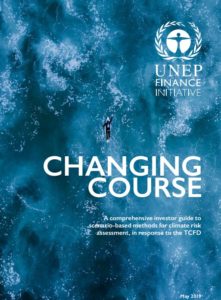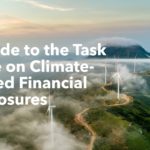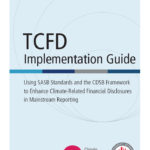
Twenty institutional investors from eleven countries convened by the UN Environment Finance Initiative (UNEP FI) launched comprehensive investor guidance to help assess how climate change and climate action could impact investor portfolios around the world. These assessments enable investors to be more transparent about their climate-related risks and opportunities in line with the recommendations from the Financial Stability Board’s Task Force on Climate-related Financial Disclosures. They will also help investors contribute to and benefit from the transition to low-carbon and climate-resilient economies.
Climate change is already impacting communities and economies around the world and these impacts will continue to intensify. Extreme weather events, including floods, tropical cyclones, and extreme hot and cold days are already physically impacting business operations. At the same time, policy and technology shifts ensuring that we make the transition to a low-carbon economy mean that emission-intensive companies will become less competitive. These changes pose potentially unprecedented risks—and opportunities—to institutional investors and other financial institutions who are exposed to these businesses.
Results of the analysis show that government inaction on climate change will further exacerbate costs and risks, to the tune of USD 1.2 trillion for 30,000 of the largest listed companies.
“We now know for sure that climate change will alter our living environment radically for the worse,” said Satya Tripathi, UN Assistant Secretary General and Secretary of the UN Environment Group. “If we are serious about the future of our civilization and about delivering the Paris Agreement, we will have to fully decarbonize the economy by 2050, requiring no less than a ‘green industrial revolution’. It is still possible for us to act decisively to prevent catastrophic damage to the very web of life that sustains all species on the planet, including us humans.”
The guide provides a state-of-the-art overview of approaches, tools, and providers available to investors today. It also details the methodologies piloted by the 20 investors and summarises their experiences. Some key findings are below:
- Investors face as much as 13.16% of risk from the required transition to a low-carbon economy: The 1.5°C scenario, in line with the latest special report by the Intergovernmental Panel on Climate Change (IPCC), exposes companies to a significant level of transition risk, affecting as much as 13.16% of overall portfolio value. Considering that total assets under management AUM) for the largest 500 investment managers in the world total USD 81.2 trillion, this would represent a value loss of USD 10.7 trillion.
- It is at the sector level that climate-related risks, including risks from the transition to a low-carbon economy, become acutely apparent. Utilities, transportation, agriculture as well as mining & petroleum refining sectors stand out as having high policy risk. Under a 1.5°C scenario, the utility sector is most strongly exposed to policy risk (-50.6% at risk), however, the sector contributes less than 10% overall to the portfolio’s climate-related risks. On the other hand, Manufacturing has a much lower risk of -16.5%, but gets the highest portfolio contribution of 46.7%. This showcases the significant variation in climate risk levels between sectors, while also highlighting how diversification can help to reduce these risks.
- ‘Green profits’ in a 2°C world are significant – approximately USD 2.1 trillion. Addressing climate change and limiting global warming requires economic policies that support a low carbon energy transition. However, green revenues generated from the sale of low carbon technologies, which support the transition, will help companies offset costs from complying with greenhouse gas (GHG) reduction policies. Stronger climate policy therefore also translates into an increased potential for companies to generate green profits. Under the 2°C scenario, the sum of all green profits generated by this 30,000-company universe equals approximately USD 2.1 trillion.
- Low carbon technology opportunities offset risk: Aggregated technology opportunities across a portfolio will offset losses generated under the 3°C, 2°C and 1.5°C policy scenarios. The portfolio’s value increases by 3.21%, 6.94%, and 10.74% under these scenarios, respectively.
- Investors face increased risk if governments act late: Finally, if governments delay action to enact climate policies that reduce GHG emissions, investors face a further loss of 1.2 trillion USD off of AUM as compared to a scenario where climate policy is enacted smoothly and steadily with immediate effect. Furthermore, delayed action not only increases policy risk, but also results in much greater physical climate risk due the increased accumulation of GHG concentrations in our atmosphere.
Applying the current methodology – and mindful of the current gaps and assumptions in it – to a portfolio of the 1,200 largest listed companies by global market capitalisation that mimics the MSCI World index yields the following:
- While modest, the net climate-related impacts on this diversified portfolio – across physical and transitional risks – appear most favourable under a 1.5°C rapid decarbonisation scenario, and least so under a less ambitious 3.0°C pathway. While aggregate impacts, both positive and negative, offset to close to zero, with an overall CVaR of +0.05% for the 1.5°C scenario. For the 2°C scenario, the overall result is slightly negative at -0.46%, and even more negative at -0.8% for the 3°C scenario[1]. The slightly positive impact of the 1.5°C scenario results from a substantial amount of technology opportunities which outweigh the negative policy and physical risk impacts.
- ‘Green revenues’ in a 1.5°C world are six times that of a 3°C world. Addressing climate change and limiting global warming requires economic policies to support the green energy transition. Low-carbon technologies are thus accelerated in a scenario where the world is more ambitious in reducing CO2 emissions. This translates into an increased potential in green revenues for companies. The portfolio’s aggregated technology opportunities are 0.75%, 2.32%, and 4.56% for 3°C, 2°C and 1.5°C respectively.
As part of the finance sector, investors have a key role to play in safeguarding financial stability and catalysing decarbonisation and climate adaptation. The Task Force’s recommendations are ground-breaking as they encourage investors to disclose the climate-related impacts on their investments and to look into the future through scenario analysis. Investors who take a long-term approach and are transparent about climate-related risk contribute to building a more resilient financial sector.
“In 2015, I spoke of the ‘Tragedy of the Horizon’ – the catastrophic impacts of climate change will be felt beyond the traditional horizons of most banks, investors and financial policymakers, who do not have the direct incentives to fix them,” said Governor of the Bank of England, Mark Carney. “Since then, important progress has been made from the Paris Accord to advances in managing the risks around climate change and optimising the returns in the transition to a low carbon economy. For the first time, a path to break this Tragedy is becoming possible.”
The investors that led this work are Addenda Capital, Aviva, Bentall Kennedy, Caisse de Dépôt et Placement du Québec, Citibanamex, City Developments Limited, Desjardins Group, DNB, Investa, KLP, La Francaise Group, LaSalle Investment Management, Link REIT, Manulife Asset Management, M&G, Nordea Investment Management, Norges Bank Investment Management, Rockefeller Asset Management, Storebrand Asset Management, and TD Asset Management.
They were guided in this work by advisory and modelling firms Carbon Delta and Vivid Economics.
“The planet does not have time for excuses,” said Maurice Tulloch, CEO, Aviva plc. “Investors have a central role to play in moving the world to a low-carbon future. This collaboration shows how we can all take better decisions, for our customers and for the environment. Aviva will keep calling for proper disclosure from the companies we invest in, while working with regulators and policymakers to make sure capital markets properly take account of these risks. The cost of doing nothing is far greater than any costs incurred by taking action.”
Download a copy of the report here.



